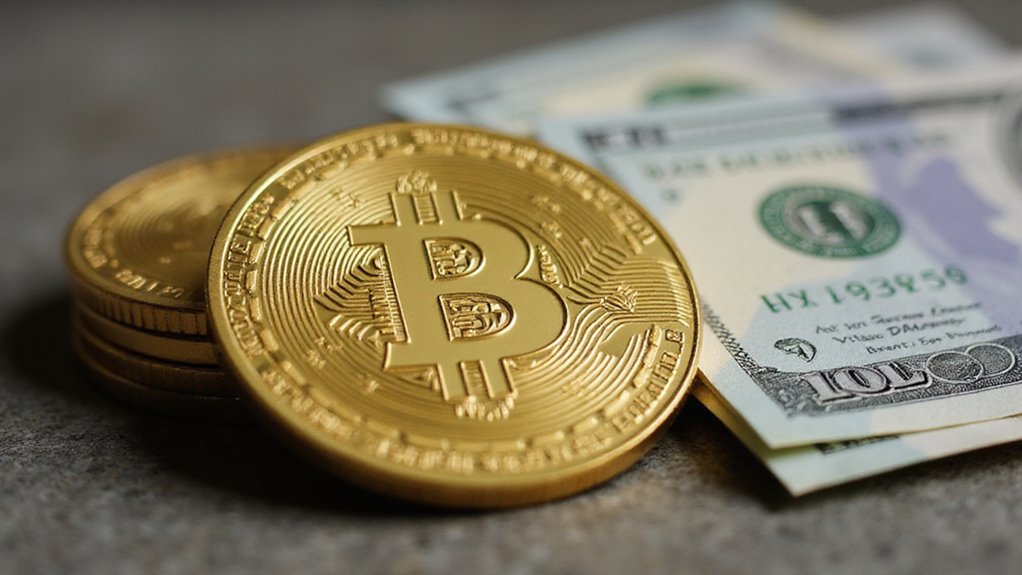Stablecoins elegantly solve cryptocurrency’s notorious volatility problem, offering the blockchain’s innovation without the roller-coaster price action. These digital assets maintain consistent value by pegging to stable reserves—fiat currencies, commodities, other cryptocurrencies, or algorithmic mechanisms. Since Tether’s 2014 debut, stablecoins have evolved into essential financial infrastructure, facilitating everyday transactions, cross-border transfers, and DeFi operations. Regulatory frameworks like the EU’s MiCA aim to address concerns about reserve adequacy. Further exploration reveals why these pragmatic instruments might represent crypto’s most practical contribution to global finance.

Why have cryptocurrencies, despite their revolutionary potential, struggled to achieve mainstream adoption as everyday currencies?
The answer lies, rather predictably, in their notorious volatility—a characteristic that renders Bitcoin and its brethren fascinating investment vehicles but woefully impractical for purchasing one’s morning coffee (unless one enjoys the peculiar thrill of potentially paying $8 today and $12 tomorrow for the same mediocre brew).
Enter stablecoins: the pragmatic compromise between cryptocurrency innovation and practical financial utility.
These digital assets maintain consistent value by pegging themselves to more stable assets like fiat currencies or commodities, effectively creating a bridge between the traditional financial system and the brave new world of decentralized finance.
Since the launch of Tether in 2014, stablecoins have evolved from a niche concept to a foundational element of the cryptocurrency ecosystem.
The stablecoin landscape presents several distinct varieties, each with its own risk-reward profile.
Fiat-backed stablecoins maintain reserves of currencies like the US dollar, while commodity-backed alternatives anchor themselves to assets such as gold.
More adventurous options include cryptocurrency-backed stablecoins (collateralized by other digital assets) and algorithmic stablecoins, which maintain their peg through complex mathematical mechanisms rather than tangible reserves.¹
These digital assets have found utility far beyond merely hedging against crypto market fluctuations.
They facilitate cross-border transactions, provide essential infrastructure for decentralized finance platforms, and serve as convenient on-ramps for cryptocurrency markets.
Their stable value proposition makes them particularly suitable for everyday transactions and as collateral in financial contracts.
The European Union has established MiCA regulations to provide a comprehensive framework for crypto-assets, including stablecoins, that aims to protect consumers while fostering innovation.
Regulatory bodies worldwide are increasingly implementing frameworks to ensure stablecoins comply with financial laws while protecting investors from potential risks.
Yet stablecoins are not without their challenges.
Most stablecoins are designed to be non-interest bearing instruments, meaning holders receive no returns despite having capital locked in these assets.
Questions regarding reserve adequacy persist, particularly during market turbulence, while algorithmic varieties face perpetual skepticism about their ability to maintain their pegs during extreme conditions.
Regulatory uncertainty further complicates their adoption, with authorities worldwide struggling to categorize and govern these hybrid financial instruments.
As the cryptocurrency ecosystem matures, stablecoins will likely remain essential components—evolving alongside technological innovations and regulatory frameworks to offer increasingly sophisticated stability mechanisms in an inherently volatile market.
¹ Algorithmic stablecoins represent perhaps the most ambitious experiment in the space—attempting to achieve through code what traditionally requires physical backing.
Frequently Asked Questions
How Do Stablecoins Maintain Their Value During Market Crashes?
Stablecoins weather market turbulence through varied mechanisms—reserve-backed variants rely on high-quality assets (cash, government securities) that resist volatility’s siren call, while algorithmic versions deploy code-driven supply adjustments that function until confidence evaporates.
Crypto-collateralized models demand excessive collateral ratios, creating precautionary buffers against liquidation cascades.
The truly resilient ones combine pristine reserve composition with operational safeguards, though market history suggests even these bastions of stability aren’t immune to extreme pressure (see: Terra’s spectacular implosion).
Can Stablecoins Be Used for International Remittances Effectively?
Stablecoins offer a compelling solution for international remittances, slashing the exorbitant fees (1-3%) that traditional services inexplicably consider reasonable.
Their blockchain foundation enables near-instantaneous settlement—rather than the customary days-long wait that somehow remains acceptable in 2025—while facilitating transactions in regions where conventional banking remains elusive.
Despite regulatory hurdles and infrastructure limitations (challenges that any financial innovation invariably faces), their growing adoption among diaspora communities and BRICS nations suggests a transformative potential in cross-border payments.
What Happens if a Stablecoin Issuer Goes Bankrupt?
When a stablecoin issuer bankrupts, the consequences can be remarkably grim for holders.
The GENIUS Act now permits such issuers to file for bankruptcy, theoretically prioritizing stablecoin holders over other creditors—though one might question the practical value of this “priority” when legal fees devour the asset pool.
Without bankruptcy protection, holders face a chaotic scramble for remaining assets, while counterparties with swap and repo positions often extract value first, leaving retail investors holding digital IOUs from an empty vault.
Are Algorithmic Stablecoins Safer Than Collateralized Ones?
No, algorithmic stablecoins are generally considered riskier than their collateralized counterparts.
While algorithmic models offer decentralization benefits, history has shown their vulnerability to catastrophic de-pegging events (Terra’s collapse being a sobering reminder).
Collateralized stablecoins, with their tangible asset backing and transparent reserves, provide a more predictable stability mechanism that withstands market turbulence.
The majority of institutional and retail users gravitate toward collateralized options precisely because of this enhanced safety profile.
How Do Stablecoin Regulations Differ Across Major Countries?
Stablecoin regulations display remarkable heterogeneity across jurisdictions.
The EU’s MiCA framework provides thorough oversight, while the UK prioritizes fiat-backed stablecoins with systemic payment integration.
The US, amid political shifts, is crafting legislation supporting dollar stablecoins through Congressional bills.
Meanwhile, Hong Kong advances with regulatory sandboxes, and Latin American frameworks remain nascent.
This regulatory mosaic creates a fascinating patchwork where compliance requirements—and by extension, operational feasibility—vary dramatically depending on one’s geographical coordinates.









